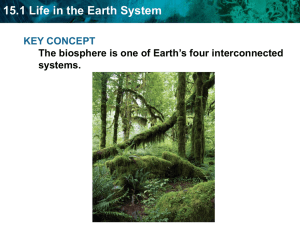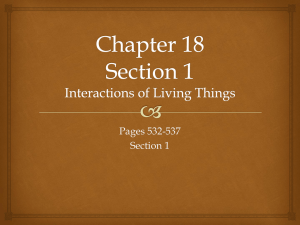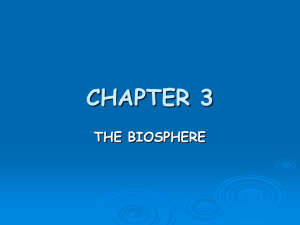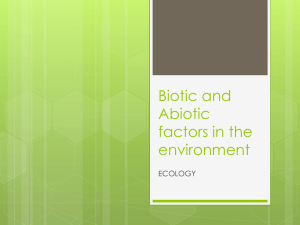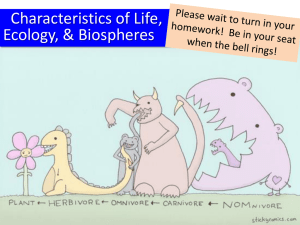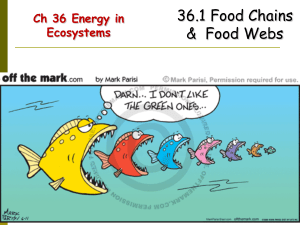Energy and Matter Exchange in the Biosphere
advertisement
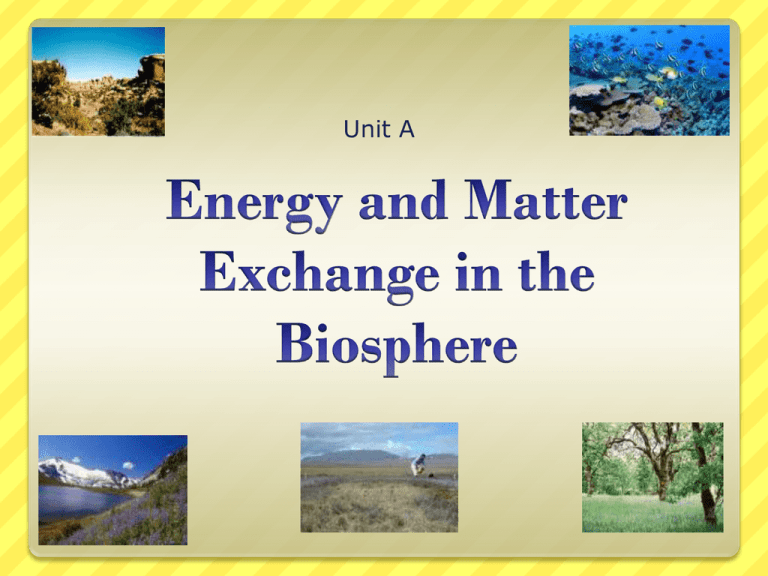
Unit A Systems Objects or groups of objects that has a relationship to something else Open Energy and matter cross the systems boundaries humans, trees Closed Allows energy but not matter to cross boundary Earth, Biosphere Isolated Allows neither energy or matter to flow across boundary Universe BIOSPHERE Radiant energy from sun interacts with a thin layer of air, land and water on or near the earth’s surface All life on earth exists here Living (biotic) and non living (abiotic) components Closed system No real boundaries, everything on Earth is connected. Do not see countless interactions or the impacts of human activity Biosphere 3 zones 1.Lithosphere (land) 2.Hydrosphere (water) 3.Atmosphere (air) continuously interact and these interactions change daily Biosphere Part A: Make a chart that compares and contrasts the three components of the biosphere Part B: Briefly explain how each part of the biosphere supports life Levels of Biosphere Biosphere Made up of Ecosystems Made up of all the abiotic and biotic elements of one specific area Made up of Communities All biotic elements in a specific ecosystem Made up of Populations Groups of similar species in a specific community Made up of Organisms A single being within a specific population Matter Cycling in the Biosphere organisms depends on matter already available on earth (closed system) It is possible that a carbon atom that helped make up a T Rex 70 million years ago can be somewhere in your body New matter is not introduced so nutrients are cycled and recycled between the environment and organisms These cycles are called the BIOGEOCHEMICAL CYCLES Matter Matter is mostly made up of the following elements and there is a specific cycle for each: Carbon Hydrogen Oxygen Nitrogen Carbohydrates (energy for cells) Lipids (storage in cells) Proteins (structure in cells) Nucleic Acids (genetic material in cells) These four elements make up all basic compounds used by living organisms Biogeochemical Cycles Cycling of matter through biotic and abiotic parts of ecosystems allows organisms to obtain essential nutrients O, C, N, travel easily in both water & air P does NOT travel in air but in soil and water Similar and interrelated Disruptions in one can affect another Nutrient Reservoirs At each step in every cycle, substances are temporarily stored in nutrient reservoirs (organisms, soil, air, water)or move from reservoir to reservoir E.g. Carbon cycles from producer to consumer to decomposers and back to atmosphere rapidly Fossil fuels is stored carbon that is unavailable to organisms for millions of years The Cycling of Matter in the Biosphere Hydrological Cycle Water absorbs and release thermal energy and moderates temperature fluctuations Medium in which metabolic reactions take place Is an excellent solvent Makes up over 60% of the cell’s mass Product and reactant of photosynthesis and cellular respiration Abiotic (air, water, land) and biotic organisms Carbon/Oxygen Cycle Carbon Key element for living things Cellular respiration/photosynthesis Biotic and abiotic (air, land, water) Rapid Cycling Plants animals and decomposers play important role Forest fires Slow Cycling 3 main reservoirs of carbon in the atmosphere, oceans, earth’s crust Weathering Carbon Cycle Phosphorus Cycle Phosphates Short Term Cycle Long Term Cycle Key elements in making ATP and calcium in bones Animals obtain phosphorus by consuming foods such as milk, grain and meat Producers such as plants and algae can only use it in forms of phosphates which dissolve in water NOT IN AIR living organisms Rocks in Earth’s crust Phosphorus Cycle Nitrogen Cycle Nitrogen Nitrogen Fixation Ammonification Denitrification Makes up 78.1% of atmosphere Essential part of proteins and DNA Abiotic (Air, water, land) and biotic Process to convert atmospheric nitrogen into useable ammonium by bacteria or lightning Process of converting ammonium into nitrite then useable nitrate by bacteria so plant can use it Process of converting nitrite and nitrate back into nitrogen gas Human Impact on Cycles Carbon-deforestation, burning fossil fuels add carbon to reservoir Nitrogen and Phosphorus- Fertilizer add phosphates and nitrates to the soil Water-burning fossil fuels adds sulfuric acid and nitric acid to the water cycle (acid rain) ENERGY FLOWS AND MATTER CYCLES The need for energy All organisms need energy to stay alive Use energy to grow, maintain body processes, reproduce and some to move Energy obtained from carbs and other energy rich organic molecules The fate of energy Energy does not and cannot cycle as matter does it follows a one way path through the biosphere 1st law of thermodynamics Energy cannot be created or destroyed, it can only be converted from one form to another or transferred from one object to another 2nd law of thermodynamics No process of energy conversion is 100% efficient, with each conversion there is less energy available to do useful work Therefore a constant supply of energy is necessary to sustain life Energy Flow in the Biosphere Energy that enters ecosystem is passed from organism to organism and is used up or exits the system via heat Energy drives the biogeochemical cycles Source of earth’s energy is the sun 3 outcomes for radiant energy from the sun Radiant Energy from Sun 1% generates wind 30% reflected by clouds or surface of earth >0.02 % is used by plants to create useable energy 40% heats atmosphere and earth’s surface 25% heats and evaporates water 30% is reflected back into space ALBEDO EFFECT Describes the amount of reflected energy Greater the ability of area to reflect sun the higher albedo therefore the lower the energy absorption (light coloured, thick cloud cover, dusty or “bald” -80%) Lower the ability of area to reflect sun the lower the albedo therefore the higher the energy absorption (forest canopies and water 25%) Average is 30 % 19% absorbed by atmosphere Gases such as H2O vapor & CO2 in atmosphere Will heat the atmosphere or radiate back into space 51% reaches surface of Earth Absorbed by land and ocean, warms surface Heat radiates upward and back into space Of the energy that reaches ground only small fraction reaches organisms for photosynthesis Amount varies depending on type of organisms and intensity of light Fraction of light that reaches is small but about 150 billion tonnes to 200 billion tonnes of organic (carbon) matter is produced each year and this is the matter that supports most life on earth. 0.023% of suns energy is used by living organisms PHOTOSYNTHESIS AND CELLULAR RESPIRATION Two chemical processes that occur in nature to help animals and plants turn solar energy into useable energy Plants use PHOTOSYNTHESIS to convert energy 6CO2 + 6H2O + energy --> 6O2 + C6H12O6 Animals use CELLULAR RESPIRATION to release energy 6O2 + C6H12O6 --> 6H2O + 6CO2 + energy Complementary processes Balance of those O2 and CO2 in the environment 0.023% of suns energy is used by living organisms Tracing the path energy takes from the sun to organisms living on earth FOOD WEBS/CHAINS visually show us the step by step or interlocking “feeding” relationships between organisms Putting organisms into classifications helps to organize the way they gain energy from the sun Three main levels in basic food chains/webs 1. 1st Trophic Level = Producers = Autotrophs 2. 2nd Trophic Level = Primary Consumers = Heterotrophs 3. 3rd Trophic Level = Secondary Consumers = Heterotrophs Energy and the food chain Energy is neither created nor destroyed therefore once it enters a system it stays and is either used up or lost as heat into the system As you move up the trophic levels the amount of energy available goes down Only 10% of energy from each level is passed on The number of organisms at each level is directly controlled by the amount of energy available to each level ECOLOGICAL PYRAMIDS (pg 28-32) Visuals that help represent the energy flow in a system Three types of pyramids 1. Pyramid of Biomass A measure of total dry mass of all living things in the ecosystem 2. Pyramid of Energy A measure of energy at each level 3. Pyramid of Numbers A count of the number or organisms at each level Human impact on Energy Hunting and fishing Monocultures Flow of Matter and Transfer of Energy are linked Six cycles involve biotic and abiotic environment When living organisms take on nutrients those nutrients become part of the biotic environment Transfer of energy from organism to organism affect biogeochemical cycles Balance of Matter and Energy Earth is similar to organisms must maintain conditions within certain limits to ensure a state of balance (Dynamic EQUILIBRIUM) Gaia hypothesis-James Lovelock- Biosphere regulates itself, needs constant input of energy and cycling of nutrients Ecosystem Productivity Rate at which an ecosystem’s producers capture and store energy within organic compounds over a certain length of time Rate of productivity depends on a number of variables Biotic factors Number of organisms at each level especially producers and decomposers Abiotic factors Temperature, amount of light and heat, rainfall, nutrient availability Ecosystem Productivity This is measured in energy/area/year (J/m2/a) We look at how much BIOMASS is created by the organisms Look at the diagram! Replicating Earth’s Biosphere Scientist have tried to replicate the self regulating conditions of the biosphere in artificial environments Biosphere 2 Large scale biosphere experiment constructed closed systems Several months until the oxygen levels dropped and carbon dioxide levels rose Proved that energy and matter exchange is extremely complex Research facility showed that delicate balance http://www.b2science.org/who/fact NASA: Advanced Life Support (ALS) Research plants grown in space for oxygen and food Conversion of waste into usable energy Self sustaining colonies for humans Devon Island (Canada) hypothetical colony on Mars http://www.nasa.gov/centers/ames/research/technology-onepagers/advanced-life-support.html


